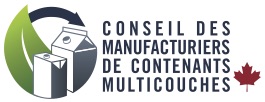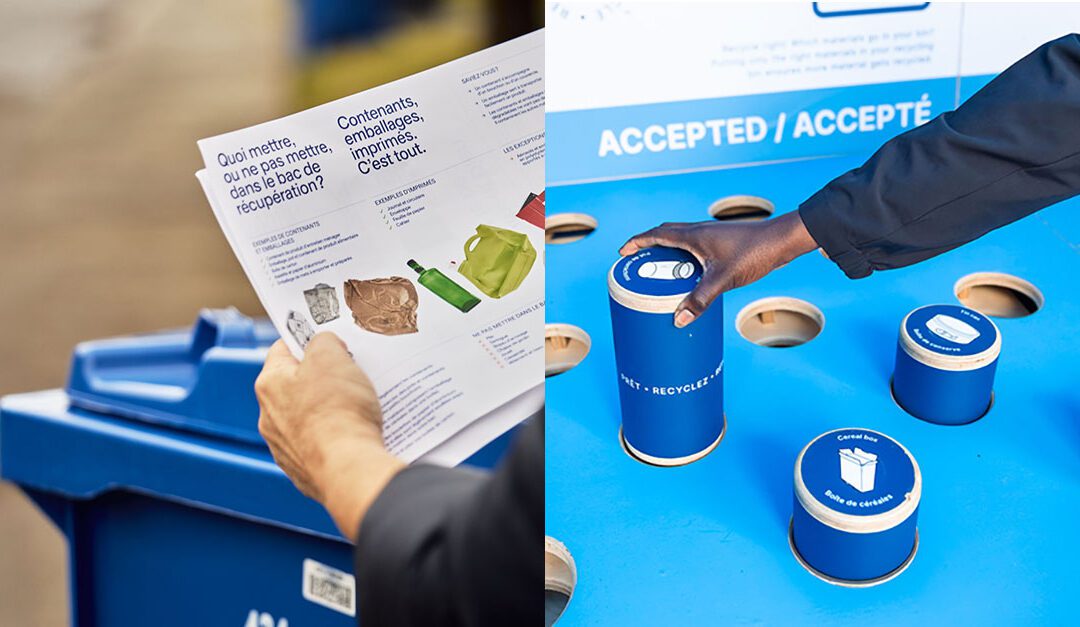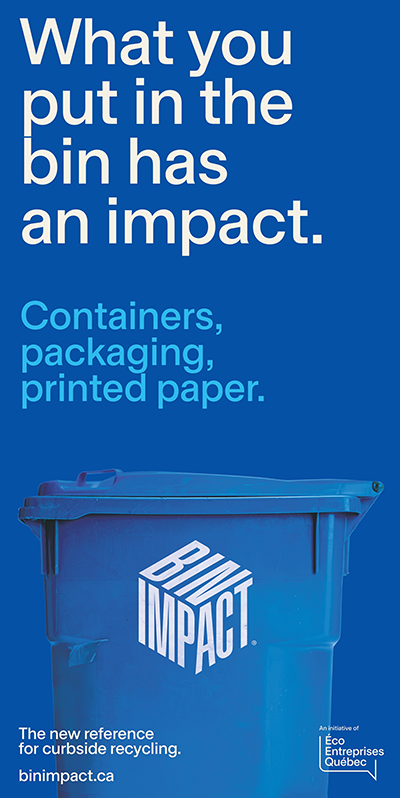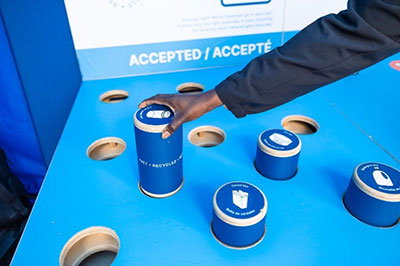The transition to full extended producer responsibility (EPR) for packaging and paper products underway in many places across Canada is reshaping how recycling is promoted and how the public is educated. In the provinces furthest along in implementing these mandates—Ontario, Québec, Alberta and New Brunswick[1]—we’ve begun witnessing the shift away from a patchwork of local promotion and education (P&E) initiatives toward harmonized, province-wide strategies spearheaded by designated producer responsibility organizations (PROs) that leverage scale while remaining attentive to local communities.
We recently turned to producer responsibility organizations Circular Materials and Éco Entreprises Québec (ÉEQ) to better understand the transformation recycling P&E is undergoing and some of the commonalities and nuances of their respective approaches.
Centralized Responsibility
P&E’s goal, as ÉEQ puts it, is to get citizens to “do the right thing when sorting,” with the practical objectives of increasing recovery rates and reducing contamination in order to meet regulatory targets. P&E used to be the domain principally of provincial agencies or local governments. Material recovery facilities (MRFs) sometimes played a part as well. Product stewardship organizations, like Carton Council of Canada, have also been known to contribute their own campaigns from time to time.
Under the new EPR regulations for packaging and paper, that responsibility now falls squarely to the companies that produce and supply these materials, and to the PROs that represent them and implement P&E on their behalf.
As the administrator of Ontario’s common collection system, the not-for-profit Circular Materials leads these efforts in the province’s multi-PRO environment in collaboration with Ryse Solutions, Landbell Canada and EnvironFocus. Circular Materials has sole responsibility for P&E in New Brunswick and Alberta as the only designated PRO for packaging and paper in those provinces, and ÉEQ holds the same position in Québec.
Harmonization and Broader Reach
One of the biggest changes taking place under EPR that’s driving the new P&E formulas is the introduction of single, harmonized material lists for entire provinces. Gone soon will be the days of communities excluding cartons or other recyclables from their bins while their neighbours accept them. These lists not only reduce confusion for residents—a welcome improvement in itself—they unlock opportunities for consistent, scalable communications.
ÉEQ introduced its accepted material list when it took over Québec’s recycling program on January 1st of this year. In Ontario, Alberta and New Brunswick, where the integration of communities into the new systems is being done gradually, the timing varies. Jennifer James, who heads P&E nationally for Circular Materials, stresses that “2026 is really going to be the year of change” for Ontario and Alberta. Ontario’s harmonized material list will come into effect on January 1, 2026. In Alberta, the date has been set for October 1, 2026. As for New Brunswick, its list will be finalized in 2027, according to James’s colleague Nadine Duguay-Lemay, who oversees P&E in the Atlantic provinces.
As harmonized material lists are introduced, PROs can implement province-wide messaging, achieving cost efficiencies and broader reach through a diversity of channels. This past June, ÉEQ launched a wide-reaching print, radio, online and social media campaign encouraging Quebecers to forget the old, complicated sorting rules and adopt a simpler approach, deliberately formulated to be accessible to citizens: “Containers, packaging, printed paper—that’s it.” TV spots and billboards are set to follow this fall.
Circular Materials’ intentions are similar. Together with the other PROs in Ontario, for instance, they are planning a province-wide campaign to launch early next year when the entire province is transitioned to the new system. In the meantime, they are actively maintaining P&E in communities during the transition period.
Local Amplification
For all their advantages, the advent of such large-scale campaigns doesn’t signal the end of local communications. During the initial phase of transition, municipal and indigenous governments are informing residents of the changes that are happening to curbside recycling. To this end, the PROs have produced customizable toolkits to assist communities in amplifying the standardized messaging. ÉEQ’s kit, for instance, includes templates for social media publications, presentations and web pages, as well as for material lists and door hangers.
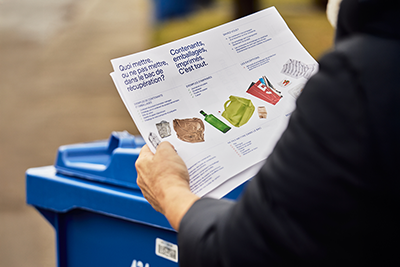
In its toolkit, ÉEQ included a template of its accepted material list for distribution by municipalities to their residents.
As for ongoing communications with residents once the new recycling systems are established, the PROs are assuming full responsibility over strategy and messaging. From there, each PRO then takes a slightly different approach. As required by regulation, Circular Materials will lead initiatives directed at residents such as local advertising and events, direct mail and the distribution of “oops!” stickers that notify households of contamination and other “challenges” in their recycling. Whereas in Québec, municipalities remain responsible for relaying the messages to residents through their own channels. Anne-Julie Maltais, senior director of communications at ÉEQ, summarizes the approach this way: “It’s the combination of a global strategy, coherent for the entire province, together with local amplification, that will lead citizens to do the right thing when sorting.”
Data-Driven Communications
To support the success of the global and local components of their P&E strategies, both Circular Materials and ÉEQ rely on newfound data collection and analysis capabilities. Centralization is providing an opportunity to gather and analyze unprecedented amounts of provincial, regional and local data to continuously fine-tune programs. As Circular Materials’ Jennifer James notes with enthusiasm: “We’re collecting metrics on everything!”
Circular Materials, for instance, draws a rich stream of intelligence from formal curbside and bale audits, compilations of infractions noted on “oops!” stickers, contact reports from customer service teams, social media interactions, focus groups, its new recycling app and other means.
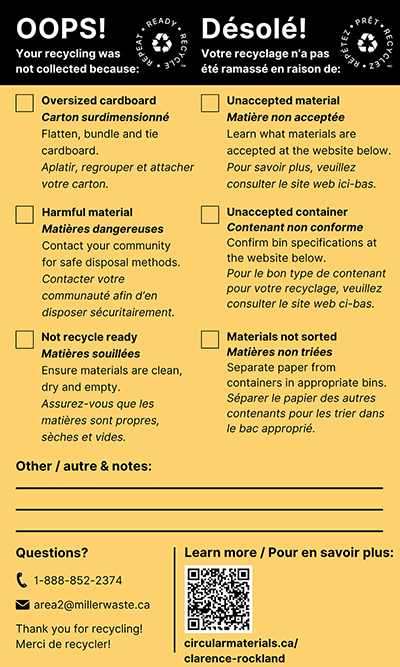
“Oops!” stickers also help Circular Materials to collect data on common recycling challenges. This one is for the Eastern Ontario bilingual city of Clarence-Rockland.
For the PRO, such insights are particularly critical. While Circular Materials has much to gain in harmonizing communications between the provinces where it operates, there is a recognition that each province has its own specificities. Jennifer James acknowledges that “there are definitely differences in how we may need to talk to residents of New Brunswick compared to Ontarians or Albertans.”
What about food and beverage cartons?
Food and beverage cartons are well integrated into the PROs’ strategies, albeit with noteworthy provincial nuances. The situation may be the simplest in Ontario, where it’s been confirmed that all types of cartons will be included in the harmonized material list for packaging and paper. During our last review of the access to carton recycling across the province, we had noted a number of communities with recycling programs that still did not accept cartons. We now have assurance that, wherever blue bin contents are collected in Ontario, so too will cartons, whether they be aseptic or gable-top, or used for food, milk or any other kind of beverage. As it has been doing throughout the transition period, Circular Materials will continue to educate residents about carton recycling as part of its P&E program.
In Alberta, all beverage containers, including cartons, are under deposit and redeemable at a depot. In New Brunswick, beverage containers are also subject to a deposit-return system (DRS), except those for milk and plant-based beverages. The understanding at this time is that the harmonized material lists and P&E tools and activities will highlight these distinctions in order to direct cartons and other beverage containers to their appropriate recovery path. For that purpose, “The recycling app will be crucial,” underscores Nadine Duguay-Lemay.
As for Québec, all beverage cartons will be incorporated into the province’s expanded DRS in March 2027. In the meantime, ÉEQ continues to educate Québec citizens on sorting materials properly and maintains its streamlined messaging: “Containers, packaging, printed paper—that’s it.” Food cartons, like those for soup and broth, will continue to be fully managed by ÉEQ.
All these changes to recycling P&E are good news for food and beverage cartons. From the start, Carton Council of Canada has looked positively upon the modernization of recycling programs that EPR promised to usher in. We particularly believe that the harmonization of sorting lists and the overall simplification of messages will make a difference to the recovery of cartons, as it will for all other targeted materials. As an organization dedicated to working with all the actors in the recycling value chain nationwide for the purpose of increasing carton recovery and recycling, Carton Council of Canada looks forward to the new systems’ further progression and opportunities for continuing to support PROs and local governments with their P&E activities featuring cartons.
[1] This article focuses on the Canadian provinces that have recently or are in the process of transitioning to full EPR for packaging and paper. It is important to note that British Columbia is unique in that it directly implemented a full responsibility model when it introduced EPR for packaging and paper in 2014.

